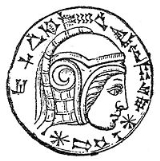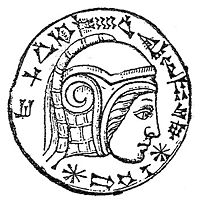
History of Lebanon under Babylonian rule
Encyclopedia
Throughout her history, the lands known today as Lebanon came under foreign rule from various powers. This article deals with the time when Lebanon and much of the Levant came under the Neo-Babylonian Empire
.
, much of Lebanon and Syria was already in their hands, since much of it was seized from the collapsing Assyrian kingdom.
was the first Babylonian King to have successfully united Mesopotamia. Having married his son of to a Median princess, he turned his attention to destroying the remnants of Assyria, which had scattered into Syria. However, his attempts to defeat the Assyrians proved fruitless until his son Nebuchadnezzar
crushed the Assyrians in 605 BC whilst his father lay ill in Babylon.
 Nebuchadnezzar's conquest of Assyria put him at odds with the Egyptian Pharaoh, whose interests lay in keeping a friendly Assyrian state in control of parts of the Levant. Consequently, the Babylonians under Nebuchadnezzar did battle with the forces of the Pharaoh. However, the Egyptians once more proved unable to defeat the Mesopotamians and in time much of Palestine fell as well. The Economic benefits included Timber from Lebanon, which greatly financed his construction projects throughout Mesopotamia.
Nebuchadnezzar's conquest of Assyria put him at odds with the Egyptian Pharaoh, whose interests lay in keeping a friendly Assyrian state in control of parts of the Levant. Consequently, the Babylonians under Nebuchadnezzar did battle with the forces of the Pharaoh. However, the Egyptians once more proved unable to defeat the Mesopotamians and in time much of Palestine fell as well. The Economic benefits included Timber from Lebanon, which greatly financed his construction projects throughout Mesopotamia.
During his rule, Jerusalem rebelled twice, resulted in two sieges. In the second siege Nebuchadnezzar's forces captured Jerusalem and inflicted a terrible sacking of the city, with the Holy Temple destroyed and thousands of Jews marched of to captivity in Babylon, as famously recorded in the Bible.
Neo-Babylonian Empire
The Neo-Babylonian Empire or Second Babylonian Empire was a period of Mesopotamian history which began in 626 BC and ended in 539 BC. During the preceding three centuries, Babylonia had been ruled by their fellow Akkadian speakers and northern neighbours, Assyria. Throughout that time Babylonia...
.
Background
Prior to the rise of the Babylonian Empire in the late 7th century BC, Lebanon had been a well-sought after land in the eastern Mediterranean with Hittites and then Assyrians occupying the country in the 13th - 12th centuries and 10th - 7th centuries respectively speaking. Following the collapse of the Assyrian Empire in Mesopotamia, Assyrian forces continued to resist their opponents evacuating into Syria, with the Neo-Babylonians under the Chaldean Nabopolassar being the most formidable enemy of them all. As the Babylonians finally defeated the Assyrians at CarchemishBattle of Carchemish
The Battle of Carchemish was fought about 605 BC between the allied armies of Egypt and Assyria against Babylonia.- Background :When the Assyrian capital Nineveh was overrun by the Babylonians in 612 BC, the Assyrians moved their capital to Harran...
, much of Lebanon and Syria was already in their hands, since much of it was seized from the collapsing Assyrian kingdom.
Nabopolassar (625 - 605 BC)
NabopolassarNabopolassar
Nabopolassar was the king of the Babylonia and played a key role in the demise of the Assyrian Empire following the death of the last powerful Assyrian king, Ashurbanipal...
was the first Babylonian King to have successfully united Mesopotamia. Having married his son of to a Median princess, he turned his attention to destroying the remnants of Assyria, which had scattered into Syria. However, his attempts to defeat the Assyrians proved fruitless until his son Nebuchadnezzar
Nebuchadnezzar
Nebuchadnezzar was the name of several kings of Babylonia.* Nebuchadnezzar I, who ruled the Babylonian Empire in the 12th century BC* Nebuchadnezzar II , the Babylonian ruler mentioned in the biblical Book of Daniel...
crushed the Assyrians in 605 BC whilst his father lay ill in Babylon.
Nebuchadnezzar (604 - 562 BC)

During his rule, Jerusalem rebelled twice, resulted in two sieges. In the second siege Nebuchadnezzar's forces captured Jerusalem and inflicted a terrible sacking of the city, with the Holy Temple destroyed and thousands of Jews marched of to captivity in Babylon, as famously recorded in the Bible.

